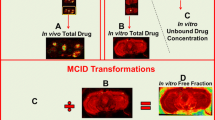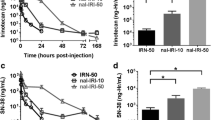Abstract
Purpose. The following experiments determined whether intravenous infusions of Cereport enhance delivery of chemotherapeutics and prolong survival in rats with metastatic tumors in the brain.
Methods. Autoradiography and scintillation were used to examine uptake of the lipophilic (paclitaxel and carmustine) and the hydrophilic (carboplatin) chemotherapeutic agents, as well as the large hydrophilic marker, 70 kDa dextran. Cereport was also tested in combination with the chemotherapeutic drugs carboplatin, vinorelbine, gemcitabine and carmustine to determine if Cereport could enhance the survival benefit beyond that provided by chemotherapy alone.
Results. Cereport enhanced the uptake of carboplatin and dextran, but not paclitaxel or carmustine. The pattern of Cereport's uptake effect with carboplatin revealed that Cereport selectively increased the proportion of highly permeable regions. Survival was significantly enhanced when Cereport was combined with either carboplatin, vinorelbine, or gemcitabine, but not carmustine, compared to each chemotherapeutic agent alone.
Conclusions. These data provide the first evidence that Cereport, or any receptor-mediated approach intended to enhance the permeability of the blood-brain tumor barrier, can increase the delivery hydrophilic drugs to metastatic tumors in the brain, increasing survival in tumor-bearing rats.
Similar content being viewed by others
REFERENCES
K. Radhakrishnan, N. I. Bohnen, and L. T. Kurland. Epidemiology of brain tumors. In: R Morantz and J Walsh (eds), Brain Tumors: A Comprehensive Text. Marcel Dekker, New York, pp. 23-32.
E. S. Nussbaum, H. R. Djalilian, K. H. Cho, and W. A. Hall. Brain metastases: Histology, multiplicity, surgery and survival. Cancer 78:1781–1788 (1996).
J. S. Loeffler, R. A. Patchell, and R. Sawaya. Treatment of Metastatic Cancer. In V DeVita, S Hellman, and S Rosenberg (eds), Cancer: Principles and Practice of Oncology. Lippincott-Raven, Philadelphia, pp. 2523-2536.
P. Morris. Interventional neuroradiology in the treatment of brain tumors. Neuroimaging Clin. N. Am. 9:767–778 (1999).
W. T. Yeung, T.-Y. Lee, F. D. Maestro, R. Kozak, and T. Brown. In vivo CT measurement of blood-brain barrier transfer constant of iopamidol in human brain tumors. J. Neuro-Oncol. 14:177–187 (1992).
C. R. McCurley, R. R. Shivers, and R. F. D. Maestro. Quantitative comparison of the morphology of the microvasculature of primary lung lesions and metastatic brain tumours. J. Submicrosc. Cytol. Pathol. 30:257–269 (1998).
S. Shibata. Ultrastructure of capillary walls in human brain tumors. Acta Neuropathol. 78:561–571 (1989).
R. T. Bartus. The blood-brain barrier as a target for pharmacological modulation. Curr. Opin. Drug Disc. Dev. 2:152–167 (1999).
K. Matsukado, T. Inamura, S. Nakano, M. Fukui, R. T. Bartus, and K. L. Black. Enhanced tumor uptake of carboplatin and survival in glioma-bearing rats by intracarotid infusion of bradykinin analog, RMP-7. Neurosurg. 39:125–134 (1996).
T. Inamura, T. Nomura, R. Bartus, and K. Black. Intracarotid infusion of RMP-7, a bradykinin analog: A method for selective drug delivery to brain tumors. J. Neurosurg 81:752–758 (1994).
P. J. Elliott, N. J. Hayward, R. L. Dean, and D. G. Blunt. Intravenous RMP-7 selectively increases uptake of carboplatin into rat brain tumors. Cancer Res. 56:3998–4005 (1996).
R. T. Bartus, P. J. Elliott, R. L. Dean, N. J. Hayward, R. L. Nagle, M. R. Huff, P. A. Snodgrass, and D. G. Blunt. Controlled modulation of BBB permeability using the bradykinin agonist, RMP-7. Exp. Neurol. 142:14–28 (1996).
S. R. Doctrow, S. M. Abelleira, L. A. Curry, R. Heller-Harrion, J. W. Kozarich, B. Malfroy, L. A. McCarroll, K. G. Morgan, A. R. Morrow, G. F. Musso, J. L. Smart, J. A. Straub, B. Turnbull, and C. A. Gloff. The bradykinin analog RMP-7 increases intracellular free calcium levels in rat brain microvascular endothelial cells. J. Pharm. Exp. Ther. 271:229–237 (1994).
J. A. Straub, A. Akiyama, and P. Parmar. In vitro plasma metabolism of RMP-7. Pharm. Res. 11:1673–1676 (1994).
P. J. Elliott, N. J. Hayward, M. R. Huff, T. L. Nagle, K. L. Black, and R. T. Bartus. Unlocking the blood-brain barrier: A role for RMP-7 in brain tumor therapy. Exp. Neurol. 141:214–224 (1996).
R. T. Bartus, P. Elliott, N. Hayward, R. Dean, E. L. McEwan, and S. K. Fisher. Permeability of the BBB by the bradykinin agonist, RMP-7: Evidence for a sensitive, auto-regulated, receptor-mediated system. Immunopharm. 33:270–278 (1996).
D. Emerich, P. Snodgrass, R. Dean, M. Agostino, B. Hasler, M. Pink, H. Xiong, B. S. Kim, and R. Bartus. Enhanced uptake of carboplatin into brain tumors with intravenous Cereport (RMP-7): Dramatic differences as a function of dosing parameters. Br. J. Cancer 80:964–970 (1999).
J. M. Ford, K. A. Miles, M. P. Hayball, P. W. Bearcroft, N. M. Bleehen, and C. S. Osborn. A simplified technique for measurement of blood-brain barrier permeability using CT: Preliminary results of the effect of RMP-7. In Quantitative Imaging in Oncology. 1996. Conference British Institute of Radiology, (1996) 126–155.
K. Black, T. Cloughesy, S. Huang, Y. Gobin, Y. Zhou, J. Grous, G. Nelson, K. Farahani, K. Hoh, and M. Phelps. Intracarotid infusion of RMP-7, a bradykinin analog, and transport of gallium-68 ethylenediamine tetraacetic acid into human gliomas. J. Neurosurg. 86:603–609 (1997).
T. Cloughesy, K. Black, Y. Gobin, K. Farahani, G. Nelson, P. Villablanca, F. Kabbinavar, F. Vinuela, and C. Wortel. Intraarterial Cereport (RMP-7) and carboplatin: A dose escalation study for recurrent malignant gliomas. Neurosurg 44:270–278 (1999).
F. Yuan, H. A. Salehi, Y. Boucher, V. S. Vasthare, R. F. Tuma, and R. K. Jain. Vascular permeability and microcirculation of gliomas and mammary carcinomas transplanted in rat and mouse cranial windows. Cancer Res. 54:4564–4568 (1994).
R. K. Jain. Delivery of molecular and cellular medicine to solid tumors. In The Eugene M. Landis Award Lecture. 1997. Conference Microcirculation, (1997) 1023.
S. K. Hobbs, W. L. Monsky, F. Yuan, W. G. Roberts, L. G. Griffith, V. P. Torchilin, and R. K. Jain. Regulation of transport pathways in tumor vessels: Role of tumor type and microenvironment. Proc. Natl. Acad. Sci. USA 95:4607–4612 (1998).
M. Nomura, S. Yamagishi, S. Harada, T. Yamashima, J. Yamashita, and H. Yamamoto. Placenta growth factor (PlGF) mRNA expression in brain tumors. J. Neuro-Oncol. 4:123–130 (1998).
W. L. Monsky, D. Fukumura, T. Gohongi, M. Ancukiewcz, H. A. Weich, V. P. Torchilin, F. Yuan, and R. K. Jain. Augmentation of transvascular transport of macromolecules and nanoparticles in tumors using vascular endothelial growth factor. Cancer Res. 59: 4129–4135 (1999).
M. Dellian, B. P. Witwer, H. A. Salehi, F. Yuan, and R. K. Jain. Quantitation and physiological characterization of angiogenic vessels in mice: Effect of basic fibroblast growth factor, vascular endothelial growth factor/vascular permeability factor, and host microenvironment. Am. J. Pathol. 149:14–28 (1996).
R. T. Bartus, P. Snodgrass, J. Marsh, M. Agostino, A. Perkins, and D. F. Emerich. Intravenous Cereport (RMP-7) modifies topographic uptake profile of carboplatin within rat glioma and brain surrounding tumor, elevates platinum levels and enhances survival. J. Pharmcol. Exp. Ther. (in press, 2000).
G. Riley, N. Kim, V. Watson, Y. Gobin, C. LeBel, K. Black, and R. T. Bartus. Intra-arterial administration of carboplatin and the BBB permeabilizing agent, RMP-7: A toxicological evaluation in swine. J. Neuro-Oncol. 36:167–178 (1998).
Author information
Authors and Affiliations
Rights and permissions
About this article
Cite this article
Emerich, D.F., Dean, R.L., Marsh, J. et al. Intravenous Cereport (RMP-7) Enhances Delivery of Hydrophilic Chemotherapeutics and Increases Survival in Rats with Metastatic Tumors in the Brain. Pharm Res 17, 1212–1219 (2000). https://doi.org/10.1023/A:1026462629438
Issue Date:
DOI: https://doi.org/10.1023/A:1026462629438




